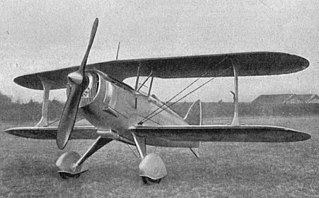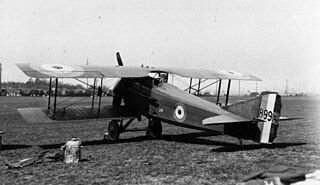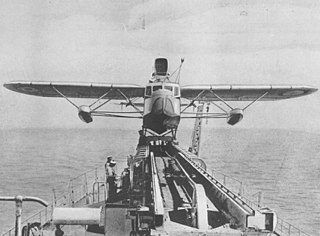
The Blériot SPAD S.510 was a French single-seat, single-engined biplane fighter aircraft. First flying in 1933, 60 were built for the Armée de l'Air, entering service in 1936. The type remained in service as a fighter-trainer at the start of the Second World War. It was the last French biplane fighter to enter production.

The SPAD S.VII was the first of a series of highly successful biplane fighter aircraft produced by Société Pour L'Aviation et ses Dérivés (SPAD) during the First World War. Like its successors, the S.VII was renowned as a sturdy and rugged aircraft with good climbing and diving characteristics. It was also a stable gun platform, although pilots used to the more manoeuvrable Nieuport fighters found it heavy on the controls. It was flown by a number of the famous aces, such as France's Georges Guynemer, Italy's Francesco Baracca and Australia's Alexander Pentland.

French Naval Aviation is the naval air arm of the French Navy. The long-form official designation is Force maritime de l'aéronautique navale. Born as a fusion of aircraft carrier squadrons and the naval patrol air force, the Aéronavale was created in 1912. The force is under the command of a flag officer officially titled Admiral of Naval Aviation (ALAVIA) with his headquarters at Toulon naval base. It has a strength of around 6,800 military and civilian personnel. It operates from four airbases in Metropolitan France and several detachments in foreign countries or French overseas territories. Carrier-borne pilots of the French Navy do their initial training at Salon-de-Provence Air Base after which they undergo their carrier qualification with the US Navy.

The Dornier Do 22 was a German seaplane, developed in the 1930s. Despite good performance, it was built only in small numbers and entirely for the export market. The type was operated in the Second World War by Finland, Greece and Yugoslavia.

Gourdou-Leseurre was a French aircraft manufacturer whose founders were Charles Edouard Pierre Gourdou and Jean Adolphe Leseurre.

Potez 25 was a French twin-seat, single-engine sesquiplane designed during the 1920s. A multi-purpose fighter-bomber, it was designed as a line aircraft and used in a variety of roles, including fighter and escort missions, tactical bombing and reconnaissance missions. In the late 1920s and early 1930s, Potez 25 was the standard multi-purpose aircraft of over 20 air forces, including French and Polish. It was also popular among private operators, notably mail transport companies.
The Letov Š-16 was a Czechoslovak single-engined, two-seat biplane bomber. It was designed by Alois Šmolík at Letov Kbely. The Š-16 first flew in 1926.

The Loire 46 was a French single-seater fighter aircraft of the 1930s. A high-winged monoplane designed and built by Loire Aviation, it was purchased by the French Air Force. It was also supplied to the Spanish Republican forces during the Spanish Civil War, but was almost out of service by the outbreak of World War II.

The Dewoitine D.1 was a French single-seat fighter aircraft of the 1920s, built by the French industrial company Dewoitine.

The Gourdou-Leseurre GL-812 HY was a 3-seat reconnaissance floatplane, built by Gourdou-Leseurre.

The Loire 130 was a French flying boat that saw service during World War II. It was designed and built by Loire Aviation of St Nazaire.

The Gourdou-Leseurre GL-832 HY was a 1930s French light shipboard reconnaissance floatplane designed and built by Gourdou-Leseurre for the French Navy.
The Gourdou-Leseurre Type A, retrospectively named the GL.1, was a prototype fighter aircraft built in France in 1918. It was a conventional parasol-wing monoplane with fixed tailskid undercarriage, with main units connected by a cross-axle. The pilot sat in an open cockpit. Construction was of fabric-covered wood and steel. Initial flight testing revealed performance superior to most contemporary biplane fighters and led to an order of 100 aircraft being placed. However, further tests suggested that the aircraft structure could be considerably lightened, and that the wing needed to be stiffened, leading to a cancellation of the order.

The Gourdou-Leseurre GL.30 was a racing aircraft built in France in 1920 which formed the basis for a highly successful family of fighter aircraft based on the same design.

The Hanriot HD.32 was a military trainer aircraft built in France in the 1920s. Derived from the HD.14 and sharing the same basic configuration as it, the HD.32 was a substantially revised design, with redesigned tailplane, undercarriage, and wings of shorter span. The HD.14's wooden construction was replaced in part with metal structure.
The Gourdou-Leseurre GL.50, also known as the Gourdou-Leseurre Type F, was a French fighter prototype of the early 1920s.

The Wibault 7 was a 1920s French monoplane fighter designed and built by Société des Avions Michel Wibault. Variants were operated by the French and Polish military and built under licence for Chile as the Vickers Wibault.

The Villiers II was a French two-seat fighter aircraft of the 1920s intended for operation from the Aircraft carrier Béarn of the French Navy. It was a single-engined tractor biplane with a waterproof hull in the form of a flying boat to allow the aircraft to be safely landed on water in an emergency. Two prototypes and 30 production aircraft were built, the type serving briefly with the French Navy, although never operated from an aircraft carrier.
The Gourdou-Leseurre GL-820 HY family of four-seat single-engined floatplanes were designed and built in France during the latter half of the 1930s by Gourdou-Leseurre. The GL-820 HY and GL-821 HY 02 were shipborne reconnaissance / observation aircraft, while the sole GL-821 HY was built as a torpedo carrier.


















